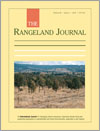RJ16013Pasture production and composition response after killing Eucalypt trees with herbicides in central Queensland
Woodlands are thickening across northern Australia reducing pasture and cattle production. We measured pasture responses after killing trees with herbicide in silver-leaved ironbark and poplar box eucalypt woodlands of central Queensland, in replicated grazing or burning experiments. The major effect of killing the trees was on increasing pasture yield, and increasing the composition of desirable perennial grass species and pasture crown cover, but the rate of pasture response varied markedly between woodland communities.




